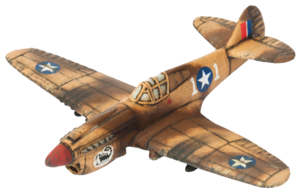P40 Warhawk

"It was sturdy and handled well, except in a spin, but you never piloted a P-40 without wishing you had something a little better."
- – Anonymous pilot
The Curtiss P-40 Warhawk was a fighter developed and used by many nations, including the United States. It is notorious for having a very mixed history as an aircraft. Historically, it has been regarded as a largely inferior aircraft and treated much like the M3 Lee was. Recent scholarship has been far more forgiving.
Early War[edit | edit source]

Mid War[edit | edit source]
Late War[edit | edit source]
In Real Life[edit | edit source]

The Curtiss Warhawk is an underappreciated aircraft. It was first developed to replace the aging P-36 Hawk to meet the demands of the USAAF for modern sleek aircraft to compete with newer European designs. While its characteristics varied somewhat from model to model, in general the P40 was immediately recognizable by the huge air scoop under its nose. In China, the Flying Tigers were the first to further personalize their P40s by painting on the distinctive shark-mouth that remains popular to this day. The P40 was also notable for carrying enough firepower to make an Ork cry, with later models carrying as many as six .50 BMGs. The variants that were sent under lend lease were called Tomahawks or Kittyhawks.
The P40 certainly looked the part of being tough and dangerous, and for the most part, it was. The main limitation of the Warhawk came down to its engine. It had no turbocharger or supercharger and so its performance dropped like a brick at high altitude. Rear visibility was also bad due to the cockpit design, and its fuel range was too low to work as a bomber escort. The Warhawk and late model Kittyhawk were on occasion flown off carriers but there was no attempt made during the war to navalize the design, partly due to the navy's preference for shorter radial engines.
That being said, Warhawks could be found in the inventories of pretty much every allied nation. The USAAF pilots differ from the Generals of the USAAF and stated in their memoirs that they had no problem using the aircraft at lower altitudes, with some being indifferent at switching to P-38s. The Soviet air doctrine of World War II favored medium and low altitude combat and found the P-40 to be an ok aircraft. The British and Australians found it very useable in the ground support role, and the Chinese were largely grateful just to have ANYTHING that flew. The P-40 was a critical factor in the African Campaign, the Burma Campaign, and the Indian Campaign.
The P-40 also was reliable enough to survive the war (though thoroughly outdated as an air superiority fighter) as a Close Air Support aircraft. The copious numbers of BMGs and ability to carry payloads of rockets and bombs made it invaluable against heavy armor, which were qualities that the Soviets in particular really appreciated.
| US Forces in Flames of War | |
|---|---|
| Tanks: | M4 Sherman - M3 Lee - M5/M3 Stuart - M24 Chaffee - M26 Pershing - M27 Tank - M6 Heavy Tank - T14 Heavy Tank |
| Transports: | M3 Halftrack - Jeep - DUKW |
| Infantry: | US Armored Rifle Platoon - Parachute Rifle Platoon - Rifle Platoon - American Rifle Company - Glider Platoon - Machine Gun Platoon |
| Artillery: | US 155mm - US 105mm Artillery - US 75mm Artillery - US 81mm Mortars - T27 Xylophone - 57mm Anti Tank Platoon - M12 155mm Artillery Battery - M7 Priest - M8 Scott |
| Tank Destroyer: | M10 - M18 Hellcat - T55 Gun Motor Carriage - M36 Slugger |
| Recon: | M3 Scout Car - M20 Security Section - M8 Greyhound Cavalry Recon Patrol |
| Aircraft: | P40 Warhawk - P47 Thunderbolt - P38 Lightning - F4U Corsair |
| Anti-Aircraft: | M15 & M16 AAA Platoon |